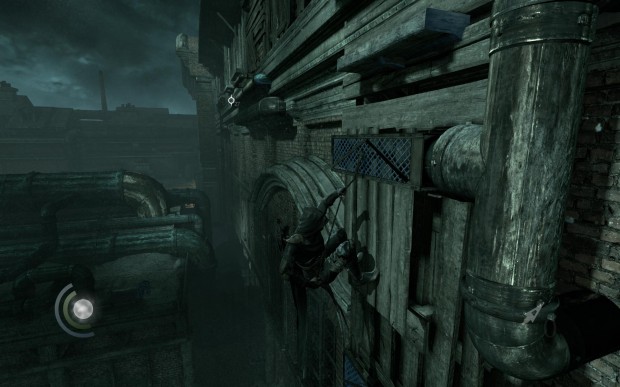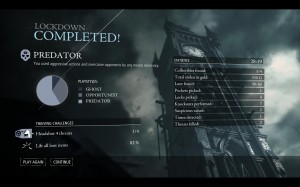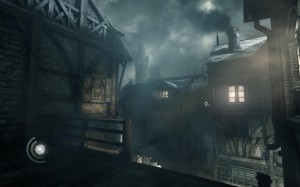Thief Review (PC)
- Updated: 24th Feb, 2014

The first thing you need to do when playing Thief is throw away all pretensions at nobility. Garrett isn’t a give-to-the-poor sort of robber. He’s more a take-anything-that-isn’t-nailed-down sort of guy; the kind that you inadvertently played in your first Elder Scrolls game except that he actually has some sense of what is and isn’t worth taking. There appears to be an insatiable demand for gold scissors in this city. I can’t imagine they’d be particularly sharp or useful but Garrett relies on them for a substantial portion of his income.
As a master thief, Garrett starts out with the basic blackjack and all abilities – climbing, crouching and sneaking are your mainstays here. Somewhere in the decade between the last game and this one, he’s forgotten how to jump but has gained the ability to “swoop”. This is a silent dash forwards, very handy for moving from cover to cover. You also have a new focus meter – a power that shows up routes, hazards and the occasional puzzle solution, as well as slowing down time for combat.
When you earn money you can donate it to the Queen of Beggars in exchange for Focus Points. These can be spent on upgrades for the different facets of your abilities – faster aiming with the bow, in-combat takedowns with the blackjack, visualisation of sound and other advantages.
New Thief doesn’t have the same emphasis on sound and footsteps that Original Thief did. You do need to pay attention to what you’re stepping on, lest you attempt a nice quiet run across what turns out to be an echoing metal floor, or crunchy glass that everyone seem to leave just lying around to injure unwary children. However, the enemies you’ll face (or preferably, avoid) in this Thief are a chatty bunch. You’ll hear them talking or see the light cast by their torches far earlier than any footsteps would give them away.
This may be down to the awkward sound balance and audio that I experienced throughout the game. During cutscenes, background characters would continue or even start their ancillary conversations, drowning out the main plot even after I adjusted the volume settings. Some lines would trigger over and over again – most memorably, the sound of a man begging to be hit harder during sex-play. I don’t think the brothel was supposed to be that haunting, but his wheedling tone followed me up and down the corridor for a full 15 minutes.
 Each of the eight chapters is a standalone environment and most objectives have multiple routes to them. At the end of each chapter you get rated on how you approached each of the obstacles – predatory (i.e. bopping people over the head or even killing them), ghost (sneaking past, leaving them unharmed) or opportunist (making use of exploits in the environment).
Each of the eight chapters is a standalone environment and most objectives have multiple routes to them. At the end of each chapter you get rated on how you approached each of the obstacles – predatory (i.e. bopping people over the head or even killing them), ghost (sneaking past, leaving them unharmed) or opportunist (making use of exploits in the environment).
You’ll need to invest in a couple of tools to really sneak around – a wrench for unscrewing ventilation grates and wirecutters for disarming traps – but it’s entirely up to you how to approach each level. In that sense, it’s much more free than the original game, where most challenges could be overcome by water arrows. New Thief guards get suspicious when their brightly burning torch goes out with a sploosh. Sometimes they’ll even relight them.
Between the chapters, you can spend time just exploring the city. You’ll hear NPCs through their paper-thin walls gossiping about this lady has a certain type of fancy bracelet, or that man keeps a valuable bust of the baron in his house. Go digging through people’s houses to find letters and clues to safe combinations and generally have fun being a master thief, filling your grubby hideout with loot, without all that plot getting in the way. Some of your NPC buddies will have sidequests as well – thief commissions that require you to get into a location, find the object and escape without being caught. Of course, these also provide another opportunity to find extra loot, lore and collectibles. While the main plot took me about 12 hours, you could easily spend 25 hours on a single playthrough.
 If you want a classic, sneaky experience without giant prompts telling you when to pick up an object, you can turn off the button prompts in the custom difficulty settings. You can also limit the arrow types if you find yourself relying too much on one and even get rid of the focus option altogether. I wouldn’t recommend this for a first go as some of the puzzle clues and trap mechanisms are very hard to spot without it.
If you want a classic, sneaky experience without giant prompts telling you when to pick up an object, you can turn off the button prompts in the custom difficulty settings. You can also limit the arrow types if you find yourself relying too much on one and even get rid of the focus option altogether. I wouldn’t recommend this for a first go as some of the puzzle clues and trap mechanisms are very hard to spot without it.
There are a few frustrating moments when you know Garrett could climb that low wall but because it’s not an officially sanctioned route, you can’t go that way. However, the multitude of routes and secret passages to discover make up for these limitations.
Thief really captures the solitary hunter spirit of the original game, with enough optional extras to make it feel modern. Thanks to some great character writing, you understand right from the start how Garrett feels about his protégé, Erin, and the world shows perfectly why the villains draw his ire. Solving some of the puzzles requires actual thinking and searching for clues, which is a welcome change, though there is one disappointing segment in the main plot that just seems to be designed around running really quickly. For the most part, the game strikes a great balance between mental challenge, game skills and sign-posting. It credits gamers with intelligence. I like this very much.
Thief will be out on PC, PS3, PS4, Xbox 360 and Xbox One from 28th February.


Follow Us!